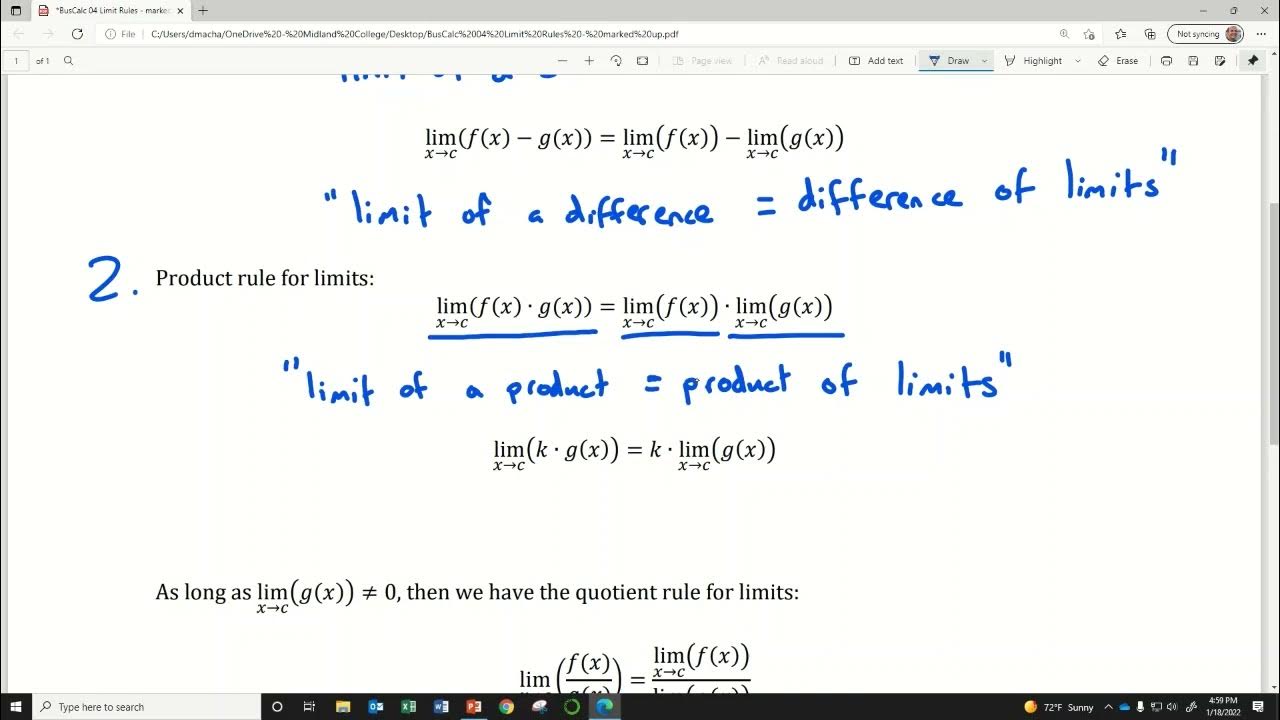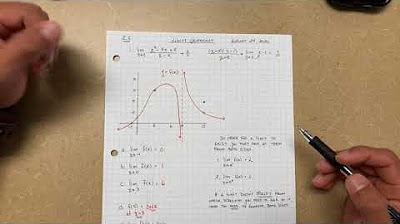Limit properties | Limits and continuity | AP Calculus AB | Khan Academy
TLDRThe video script discusses various properties of limits in functions, focusing on their intuitive understanding rather than rigorous proof. It explains the sum, difference, product, constant multiple, quotient, and exponent properties of limits. The key takeaway is that the limit of a sum or difference of functions equals the sum or difference of their individual limits, the limit of a product equals the product of their limits, and the limit of a function divided by another is the quotient of their limits. These properties are essential for simplifying and solving limit problems.
Takeaways
- 📚 The video discusses various properties of limits in mathematical functions, providing intuitive understanding without rigorous proofs.
- 🔢 If the limit of f(x) as x approaches c is L, and the limit of g(x) as x approaches c is M, then the limit of [f(x) + g(x)] as x approaches c is L + M.
- ➖ The limit of [f(x) - g(x)] as x approaches c is L - M, which is known as the difference property of limits.
- 📈 For the product of functions, the limit of [f(x) * g(x)] as x approaches c equals the product of the individual limits (L * M).
- 🅿️ When a function is multiplied by a constant k, the limit of [k * f(x)] as x approaches c is k times the limit of f(x), which simplifies to kL.
- 🔄 The limit of [f(x) / g(x)] as x approaches c is the quotient of the individual limits (L / M), provided the denominator's limit is not zero.
- 💪 The exponent property of limits states that the limit of [f(x)^(r/s)] as x approaches c is equal to (L^(r/s)), where r and s are non-zero integers.
- 📊 Visual representation of functions can often help in understanding the properties of limits intuitively.
- 🌟 The properties of limits are generally what one would naturally want to compute and are helpful in simplifying complex limit problems.
- 📝 The epsilon-delta definition of limits will be covered in a separate tutorial for those seeking a more rigorous understanding.
Q & A
What is the main purpose of the video?
-The main purpose of the video is to introduce and explain various properties of limits in mathematical functions, which can be helpful for simplifying limit problems.
Why isn't a rigorous proof provided for the properties of limits in this video?
-A rigorous proof is not provided because it would require a detailed understanding of the epsilon-delta definition of limits, which will be covered in a separate tutorial.
If the limit of f(x) as x approaches c is L, and the limit of g(x) as x approaches c is M, what is the limit of [f(x) + g(x)] as x approaches c?
-The limit of [f(x) + g(x)] as x approaches c is L + M, which is the sum of the individual limits.
What is the difference property of limits, and how is it applied?
-The difference property of limits states that the limit of [f(x) - g(x)] as x approaches c is L - M, which is the difference of the individual limits.
How does the product property of limits work?
-The product property of limits indicates that the limit of [f(x) * g(x)] as x approaches c is L * M, which is the product of the individual limits.
What happens when a constant is multiplied by a function that approaches a limit?
-The limit of [k * f(x)] as x approaches c is equivalent to k times the limit of f(x) as x approaches c, which simplifies to k * L.
What is the quotient property of limits, and how is it used?
-The quotient property of limits states that the limit of [f(x) / g(x)] as x approaches c is equal to the limit of f(x) as x approaches c divided by the limit of g(x) as x approaches c, which simplifies to L / M.
Explain the exponent property of limits.
-The exponent property of limits indicates that the limit of [f(x)^(r/s)] as x approaches c is equal to [the limit of f(x) as x approaches c] raised to the r/s power, which simplifies to L^(r/s), provided r and s are integers and s is not zero.
How do the properties of limits help in simplifying limit problems?
-The properties of limits provide a systematic way to break down and simplify complex limit problems by allowing us to perform operations such as addition, subtraction, multiplication, division, and exponentiation on the limits themselves, rather than the original functions.
Why are these limit properties considered intuitive?
-These limit properties are considered intuitive because they often reflect the natural operations we would perform on the graphs of functions. For example, adding or subtracting the graphs of two functions corresponds to adding or subtracting their limits.
How can visual representation enhance understanding of limit properties?
-Visual representation, such as graphs, can enhance understanding of limit properties by providing a geometric interpretation of the operations being performed on the functions. This can make the properties more tangible and easier to grasp intuitively.
Outlines
📚 Introduction to Limit Properties
The paragraph introduces the concept of limit properties in calculus, explaining that while a rigorous proof requires a formal definition of limits, the tutorial will focus on intuitive understanding. It sets the stage for discussing the sum rule, difference rule, constant multiple property, quotient property, and exponent property of limits, emphasizing their usefulness in simplifying limit problems.
📈 Visualization of Function Limits
This paragraph emphasizes the intuitive nature of limit properties by suggesting that visualizing the graphs of functions can help understand how limits behave under operations such as addition, subtraction, multiplication, and division. It reinforces the idea that the properties discussed are quite natural and align with what one might expect from a graphical perspective.
Mindmap
Keywords
💡limits
💡properties of limits
💡epsilon-delta definition
💡sum rule
💡difference rule
💡product rule
💡constant multiple property
💡quotient property
💡exponent property
💡intuitive
💡rigorous proof
Highlights
The video discusses various properties of limits in mathematics.
A rigorous proof of these properties requires a strict definition of limits, which will be covered in another tutorial.
The addition property of limits states that the limit of the sum of two functions equals the sum of their individual limits.
The subtraction property of limits indicates that the limit of the difference of two functions is the difference of their individual limits.
The product property of limits asserts that the limit of the product of two functions is the product of their individual limits.
The constant multiple property explains that the limit of a constant multiplied by a function is equal to the constant multiplied by the limit of the function.
The division property of limits, also known as the quotient property, means that the limit of the division of two functions is the quotient of their individual limits.
The exponent property of limits allows us to find the limit of a function raised to a power by raising the limit of the function to that power.
The video emphasizes the intuitive nature of these limit properties and their usefulness in simplifying limit problems.
The properties of limits discussed are essential for solving more complex mathematical problems involving functions.
The video provides a visual approach to understanding the properties of limits by relating them to the graphs of functions.
The sum rule, or addition property, of limits is a fundamental principle that simplifies the process of finding limits for the sum of functions.
The difference rule, or subtraction property, of limits is another basic principle that streamlines the computation of limits for the difference of functions.
The product property of limits is crucial for understanding how the multiplication of functions affects their limits.
The constant multiple property is key for determining the limit of a function when it is multiplied by a constant.
The quotient property of limits is important for calculating the limit of the division of two functions as they approach a certain value.
The exponent property of limits is a powerful tool for handling functions raised to fractional or integer powers in limit calculations.
Transcripts
Browse More Related Video

BusCalc 04 Limit Rules

Limits of combined functions: piecewise functions | AP Calculus AB | Khan Academy

Limit Laws | Breaking Up Complicated Limits Into Simpler Ones

Limits of combined functions | Limits and continuity | AP Calculus AB | Khan Academy

AP Calculus AB: Understanding how to evaluate limits algebraically and analyze limits graphically

AP Calculus AB - 1.5 Determining Limits Using Algebraic Properties of Limits
5.0 / 5 (0 votes)
Thanks for rating: